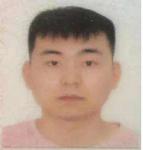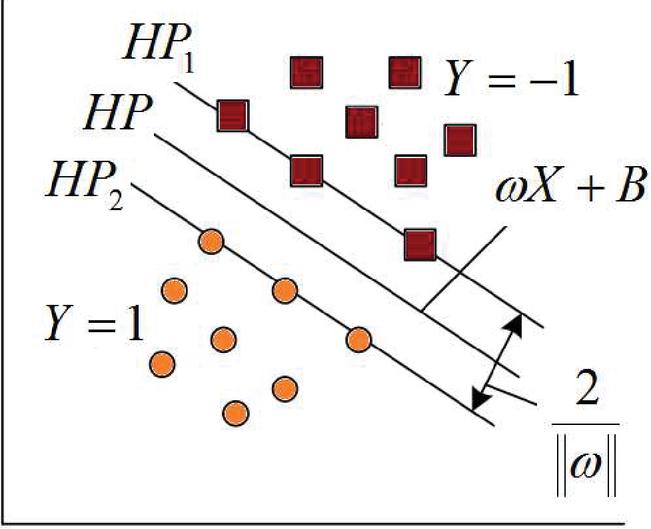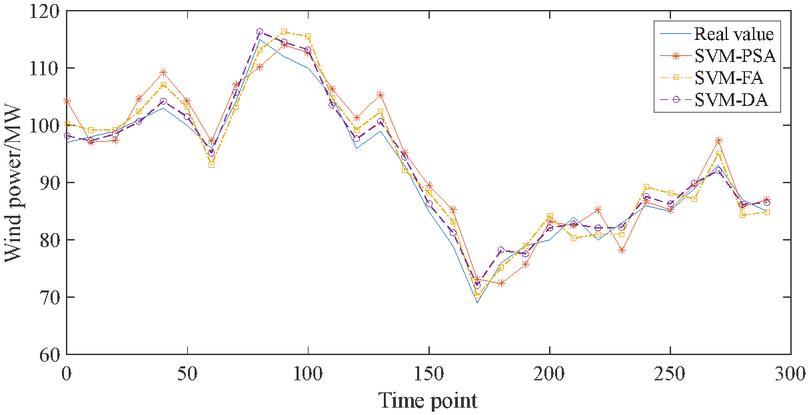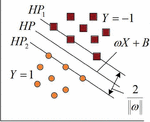Ultra Short Term Power Prediction of Offshore Wind Power Based on Support Vector Machine Optimized by Improved Dragonfly Algorithm
Yanxia Yu1,*, Yingshuai Wu1, Liang Zhao1, Xiang Li1 and Yanan Li2
1CRRC Dalian Locomotive & Rolling Stock Co., Ltd., Dalian, Liaoning, China
2LSCZ Science and Technology Co., Ltd., Suzhou, Jiangshu, China
E-mail: yuyanxia.dl@crrcgc.cc; dl.lyn@163.com
*Corresponding Author
Received 08 September 2021; Accepted 28 September 2021; Publication 30 November 2021
Abstract
In order to improve the prediction effect of ultra short term power of offshore wind power, the prediction model based on support vector machine optimized dragonfly algorithm is constructed. Based on summary of the prediction methods of wind power, the support vector machine optimized by dragonfly algorithm is established. Finally, prediction simulation analysis of offshore wind power is carried out, results show that the proposed prediction model in this research can effectively improve the computing prediction precision.
Keywords: Support vector machine, dragonfly algorithm, offshore power prediction.
Introduction
The global energy is in short supply currently, the wind energy attracts a lot of attentions in the world, the grid connection and utilization of wind power generation have been increasing quickly in the past ten years. Recently, the grid connection installing ability of wind farm increases constantly, the prediction of wind power has significant meaning. The specific intermittent and arbitrariness of wind speed come as the great challenge for reliability of wind power generator. Therefore, the correctness of predicting the offshore wind power is a critical factor of improving the quality of grid quality. The random tremor of wind power output greatly influences the safety and stability of wind power system. The accurate prediction of ultra short term wind power is an important means of ensuring stable operation of power system and improving offshore wind power consumption. The need of grid changes with electricity consumption of user, the accurate power prediction can satisfy the requirement of power system in various regions.
Chinese wind power has abundant wind energy resource, approaches the load center and is easy to be absorbed. Therefore the offshore wind power development have become the main direction of wind power development in China. Chinese coastal provinces have drawn up offshore wind power projects, Shandong province put forward a project that the installing capacity of offshore wind power attains 12.75 million kW, Guangdong province wants to increase 70 million kW wind power before 2030. The offshore wind power will become one of important power forms of coastal provinces and cities in China.
Increasing wind farm distribution area has obvious effect on fluctuation of wind power output. But repair of offshore units exists great difficulty, and the operation fee of assigning transmission cables is very expensive, offshore wind farm usually possesses the distributing features of “high concentration”, which brings output fluctuation attain to a large extent. Under different meteorological conditions, the hourly offshore wind power output can illustrate completely different fluctuation features, it greatly affects the whole performance of offshore wind power prediction model, therefore the difficulty of ultra short term offshore wind power prediction is to accurately predict wind power under different fluctuation features.
1 Related Research Progress
Recently, more attention has been given to some research scholars, and there are some outstanding progresses. Lin Wang et al. designed a deep learning model according to physical truths of wind power, and the effect of random variations of the surrounding environment is ignored [1]. Md Alamgir Hossain et al. established a comprehensive deep learning model with a novel neural network that could enhance predicting accuracy of ultra short term wind power [2]. Shuang Han et al. applied coupla transform and neural network with higher memory ability to carry out wind power prediction, and the predicting effectiveness of this theoretical model was validated according prediction simulation among different prediction models [3]. D.Y. Hong et al. used filter with higher frequency and twin similarity search model to predict ultra short term wind power, and obtained higher precision and efficiency [4]. Marcelo Azevedo Costa et al. designed a new simulation model to carry out wind power prediction, and through comparison results showed that this model can obtain higher prediction accuracy and quick convergence speed [5]. Fei Li et al. established an improved neural network to achieve the wind power prediction, the novel method had better prediction precision, and better prediction stability was obtained [6]. The existing models can obtain the better prediction effect of wind power, but the prediction precision needs to be improved, and the generalization ability also needs to be strengthened. In order to improve prediction effect of wind power, an proper algorithm should be selected. The support vector machine was put forward by Vapnik et al, it is a statistical learning theory. The support vector machine can deal with small sample learning problems. The support vector machine is an effective method for statistical learning when the number of samples is insufficient. So far the support vector machine has been applied in many fields. Bikram Kumar and Deepak Gupta proposed a new support vector machine for electroencephalogram signals, and the simulation analysis verifies the effectiveness of the proposed model [7]. Ran An et al. established a novel twin support vector machine, and this method had feature of rough margin, and the novel support vector machine was solved based on a improved decoposition algorithm. This method could obtain the higher analysis effect [8]. Hao Zhang et al. applied firefly algorithm to optimize the main parameters of support vector machine, and the optimized support vector was used to assess credit risk of supply chain finance, and the proposed model has better assessing effect through simulation analysis [9]. Ricardo ManuelArias Velásquez applied support vector machine to detect the partial discharge, and it could improve the detecting accuracy [10]. Tao Sun et al. established a novel assessment model, this method could achieve the online evaluation of lithium-ion batteries correctly [11]. Hongfei Zhu applied improved support vector machine to detect the carrot appearance, the proposed method could achieve online detection [12]. To obtain the best parameters of support vector machine, the intelligent algorithm can be selected to obtain the best parameters of support vector machine. The dragonfly algorithm belongs to a new intelligence algorithm, it was established by mirjalili et al. in 2015. Its main inspiration comes from the static and dynamic clustering behavior of dragonflies. Dragonfly groups have only two purposes: predation and migration. The former is named as static group, and the latter is named as dynamic group. In the static group, dragonflies build groups and return to a small area to search other flying prey. The main characteristics of the static group are local movement and temporary changes in flight. In the dynamic population, a large number of dragonflies make the population migrate long distances in one direction. The main idea of dragonfly algorithm is to conduct global and local search by simulating the behavior of dragonfly group navigation, predation and avoiding foreign enemies. The process of finding prey is the process of algorithm optimization. Therefore the support vector optimized by dragonfly algorithm is used to prediction ultra short term wind power.
2 Active Power Control Theory of Wind Farm
Active power control of wind farm is mainly divided into four steps:
Step 1: The power dispatching value of the power grid is processed by using the limits of the national grid standard.
Step 2: The maximum output capacity of each wind turbine in the next control cycle is predicted through the ultra short-term power prediction link, and the predicted power is fed back to the power distribution module [13].
Step 3: Through a specific power allocation strategy, the dispatching power is allocated to each wind turbine according to the unit state, predicted power and other information.
Step 4: The wind turbine controller responds to the power scheduling of the outer control to enable the unit to output the corresponding active power within its active power output capacity.
In order to achieve the control goal of reducing power generation cost, avoid frequent startup and shutdown of wind turbine units and minimize the loss of units, the power distribution objectives are as follows: (1) give priority to regulate the units in operation, and execute the startup and shutdown operation when the operating units have reached the maximum regulation capacity and still can not meet the system requirements; (2) When the dispatching power of the power grid is greater than the current active power output of the wind farm, the wind farm needs to increase the active power output. At this time, the minimum number of start-up units is taken as the distribution target; (3) When the power grid dispatching power is less than the current active power output of the wind farm, the wind farm needs to reduce the active power output. At this time, the minimum number of shutdown units is taken as the allocation target [14].
(1) Unit classification In order to distinguish the operating status of wind turbines and treat the units in different states differently in power distribution, so as to facilitate the formulation of distribution algorithm, a classification method of wind turbines is designed. The classification of wind turbines shall ensure that each unit has and only has a unique category. Based on the operation changing rules, minimum generating power and predicted power of wind turbines, wind turbines are compartmentalized into the following classifications:
The first classification is low capacity unit, the characteristics of it is listed as follows: the predicted power of the operation unit is no more than the minimum set power.
The second classification is high capacity unit, the features of it are listed as follows: predicted power of operation unit is no less than the minimum set power.
The third type is named as the shutdown unit, its predicted power is no less than the minimum set power.
The fourth type is named as shutdown fault unit or shutdown unit, its predicted power is less than the minimum set power. It also does not take part in distribution of wind power. The specific classification algorithm is as follows [15]:
| (1) |
where illustrates the classification of wind power unit, , illustrates whether the unit trigger shutdown fault, (“0” represents that no shutdown failure occurred; “1” represents that the shutdown failure occurred.) illustrates the current status of unit , (“0” represents controlling shutdown status, “1” represents normal running status). illustrates the predicted power of unit , represents the minimum setting power of unit .
(2) Lifting power margin calculation The lifting power margin is calculated according to the current actual power and predicted power of the second type of unit, that is, the adjustable amount of lifting power under the condition of maintaining operation, and generate the power up queue and power down queue respectively according to the size of the lifting power margin. Total power lifting margin is calculated by [16]
| (2) |
where represents the total power lifting margin of unit , represents the real power of unit .
The total power reduction margin is computed based on the following expression
| (3) |
where represents the total power reduction margin of unit .
(3) Lifting and reduction power distribution When power is needed to be enhanced, when the maximum power enhancing ability of the second type unit satisfies with power enhancing requirement, the power enhancing distribution should be be implemented based on the distribution rate of the wind power increase margin of the second type unit, and the set power of unit can be computed based on expression (4) [17]
| (4) |
where represents the power of wind farm needed to be increased.
When power reduction is required, if the maximum power reduction regulation capacity of the second type unit can meet the power reduction demand, the power reduction distribution shall be carried out according to the proportion of the power reduction margin of the second type unit in the total power reduction margin. The set power of unit is calculated by
| (5) |
where represents the power of wind farm needed to be reduced.
According to the model mentioned above, the role of ultra short-term power prediction of wind turbine in active power control of wind farm is as follows [18]:
(1) Power prediction provides classification criteria for unit classification: the predicted power is used as the reference value of unit generation capacity, together with real-time power and minimum set power as the classification criteria to judge whether the unit has the ability to increase or decrease power; The predicted power, together with the minimum set power, is used as the judgment standard to judge whether the shutdown and start-up unit is qualified for start-up.
(2) The power raising capacity of each unit in the second type of unit can be obtained by predicting the power and real-time power, so as to obtain the total power raising capacity of the second type of unit, and generate the power raising queue based on the power raising capacity.
(3) When power increase is required, when the maximum power increase regulation capacity of the second type unit can meet the power increase demand, the power distribution of the second type unit is realized based on the predicted power; When the maximum power up regulation capacity of the second type of unit cannot meet the power up demand, the second type of unit takes the predicted power as the set value, and the third type of unit takes the predicted power as the set power reference value for start-up operation.
3 Support Vector Machine Model Optimized By Dragonfly Algorithm
For the classification problem in the case of nonlinear classification, the basic thinking of support vector machine is to map the input space data to a high-dimensional feature vector space depending on the nonlinear transformation, then establish the better classification hyperplane in the feature space for linear classification, and finally map back to the original space to become the nonlinear classification in the input space [19].
The linear separable sample is defined by , , , , represents the total number of training samples, represents the classification signal of sample. The optimal classification hyperplane is shown in Figure 1.
Figure 1 Optimal classification hyperplane diagram.
The circle and box respectively represent two different kinds of samples, HP represents the hyperplane that can separate the two kinds of samples correctly, and the normal vector of the hyperplane is used as the direction of it. HP1 and HP2 respectively represent the plane parallel to the hyperplane and passing through the nearest distance from the hyperplane HP in the two types of samples, and the distance between them is called the classification interval. The optimal classification hyperplane means that the obtained hyperplane can not only figure out the two kinds of samples in perspective and obtain complete correct results, but also obtain the maximum classification distance between the two kinds of samples. The linear discriminant function in d-dimensional space is expressed as follows [20]
| (6) |
The hyperplane model is listed as [21]
| (7) |
Where represents the parameter vector, that is normal of hyperplane, represents the classification threshold, is the inner product operation of two vectors.
Normalize to make , samples closest to classification plane satisfy , at this moment the classification interval is . The classification plane is correct for all samples, the following condition should be satisfied:
| (8) |
For linearly separable samples, they are distinguished by the optimal classification hyperplane. For linearly non separable cases, some data does not meet the requirement of expression (7), therefore the classification error can be obtained, in order to avoid this problem, a relaxation variable is introduced into the constraint conditions. To deal with the error problem effectively, expression (7) can be converted to the form of expression (8) [22]:
| (9) |
When , the classification of sample points is right; when , the clarification of point in samples is wrong. In order to deal with this problem, the penalty item is introduced into the minimizing objective function. Where is used to control penalty degree for mis-classification. The optimal problem can be expressed by
| (10) |
where represents the upper bound of the number of misclassified samples in the sample set.
To deal with this optimization model, the optimal classification can be converted into dual form based on Lagrange function [23]
| (11) |
The linear classification after a nonlinear transformation can be achieved depending on an proper inner product function in the optimal classification surface. At present, the commonly used kernel functions mainly include polynomial kernel function, radial basis function (RBF) kernel function, hyperbolic tangent kernel function and so on.
This research uses RBF kernel function to construct support vector machine, and the form of kernel function is listed as follows
| (12) |
The classification decide equation is listed as follows
| (13) |
This research applied dragonfly algorithm to optimize the parameters and .
4 Basic Optimal Procedure of Support Vector Machine Based on Dragonfly Algorithm
Choosing kernel function has an important impact on the analysis ability of support vector machine. RBF kernel function has good convergence region and good adaptability whether it is high-dimensional data or low-dimensional data. Therefore, the RBF kernel function with wide adaptability is selected as the kernel function of SVM classification and prediction. The main parameters affecting the classification performance of RBF kernel support vector machine are penalty parameter and kernel parameter . Dragonfly algorithm takes into account all possible factors of group behavior (separation, alignment, cohesion, food attraction, natural enemy exclusion and random walk of location), so that it can quickly converge near the optimal value, and has good global optimization ability and stability [24].
Based on the above advantages, it is applied to the parameter optimization of support vector machine to find the most suitable penalty parameter and kernel parameter under the condition of ensuring the maximum classification accuracy of SVM. The optimization steps of SVM parameters based on Dragonfly algorithm are as follows.
Step 1: Initialize parameter settings. The main parameters of dragonfly algorithm are: the number of dragonflies and the maximum number of iterations of dragonflies; The main parameters of support vector machine are: the upper and lower limits of penalty parameter and kernel parameter .
Step 2: Set the corresponding data set of support vector machine. The corresponding data sets are set according to the same proportion. The main data sets are: training set and training number label, test set and test set label.
Step 3: Initialize the parameters of dragonfly: dragonfly position , the position change step , and the parameter combination (, ) is set as the combination to be optimized for support vector machine for each dragonfly. The first row of stores the value of penalty parameter , the second row of stores the value of kernel parameter . The dragonfly is initialized randomly according to range of penalty parameter and kernel parameter .
Step 4: Calculate the fitness value, the support vector machine model is trained according to training set and signal of training set, and the model is applied to classification prediction of objective set and objective signal set, the classification accuracy rate of support vector machine is considered as current fitness of each dragonfly. When dragonfly carried out a behavior operation, the maximum fitness value of current dragonfly is calculated one time. If the maximum fitness value of the current dragonfly is bigger than the stored fitness value, the current fitness value of the dragonfly is used to replace the initial stored optimal fitness value. The better value is used as optimal of the current dragonfly, the parameter combination (, ) of dragonfly corresponding to the current optimal value is stored. Otherwise , the initial fitness value and its corresponding dragonfly parameter combination (, ) are still saved.
Step 5: Look for adjacent dragonflies, The Euclidean distance is used to judge whether there are adjacent dragonflies between dragonflies. If it exists, the position is calculated by [25]
| (14) | ||
| (15) |
where represents the current iteration times, represents the position of current th generation population, represents the updating step of location of next population. represents the position of next generation population, represents the separating weight, represents the separating degree of th dragonfly; represents the alignment weight, represents the alignment degree of th dragonfly; represents the cohesion weight, represents the cohesion degree of th dragonfly; represents the food weight, represents the food of th dragonfly; represents the enemy weight, represents the enemy of th dragonfly; represents the inertia weight.
If it does not exist, the location updating formula is listed as follows [26]:
| (16) | ||
| (17) |
Where and are random number, which range from 0 to 1, is calculated by
| (18) |
Step 6: Calculate the behavior degree of each dragonfly. Calculate the separation , alignment , cohesion , food attraction and natural enemy repulsion of each dragonfly according to formulas (17)–(22).
| (19) | ||
| (20) | ||
| (21) | ||
| (22) | ||
| (23) |
where represents the velocity of th adjacent dragonfly, represents the location of food source, represents the location of enemy.
Step 7: Update the location of individual. The location is updated according to step 6, and the step size is calculated by formulation (13) [27].
Step 8: Judge whether the adjacent dragonflies meet the termination conditions of the algorithm: judge whether the preset maximum number of iterations of the dragonfly is reached. If so, output the parameter combination (, ) of the dragonfly corresponding to the maximum fitness value and the optimal value of the dragonfly. Otherwise, increase the number of iterations by 1 and jump to step 4.
5 Case Study
In order to verify the effectiveness of the proposed support vector machine optimized by dragonfly algorithm (SVM-DA), the simulation is carried out by using measured power data of an offshore wind farm and numerical weather forecast (NWP) data in 2018 and 2019. The unit capacity is 5 MW, the total installed capacity is 115 MW, and the hub height is 80 m. The data in 2018 is used as the training set and data in 2019 is used as the test set. The data of 7 days at the end of each month in 2018 are used to train the error correction model, and the data of the other days of each month are used to train the proposed prediction model. In order to eliminate the data dimension, it is necessary to normalize all the data.
In addition, the support vector machines optimized by particle swarm algorithm (SVM-PSA), and firefly algorithm (SVM-FA) are used to carry out prediction simulation analysis. The mean absolute error (MAE) and root mean squared error (RMSE) are used as evaluation indexes.
The prediction results based on different prediction model are listed in Table 1.
Table 1 Prediction results based on different prediction model
| MAE/% | RMSE/% | |||||
| Time | SVM-PSA | SVM-FA | SVM-DA | SVM-PSA | SVM-FA | SVM-DA |
| January | 8.69 | 7.63 | 6.75 | 9.57 | 8.33 | 7.66 |
| February | 8.43 | 7.39 | 6.65 | 9.35 | 8.26 | 7.48 |
| March | 8.54 | 7.46 | 6.73 | 9.43 | 8.43 | 7.75 |
| April | 8.39 | 7.35 | 6.63 | 9.26 | 8.23 | 7.32 |
| May | 8.28 | 7.19 | 6.32 | 9.18 | 8.12 | 7.15 |
| June | 8.35 | 7.32 | 6.61 | 9.24 | 8.35 | 7.43 |
| July | 8.51 | 7.44 | 6.71 | 9.46 | 8.46 | 7.46 |
| August | 8.94 | 7.79 | 6.84 | 9.85 | 8.83 | 7.83 |
| September | 8.82 | 7.85 | 6.94 | 9.74 | 8.92 | 7.91 |
| October | 8.73 | 7.68 | 6.70 | 9.65 | 8.68 | 7.73 |
| November | 8.25 | 7.15 | 6.29 | 9.13 | 8.27 | 7.35 |
| December | 8.47 | 7.44 | 6.72 | 9.38 | 8.55 | 7.49 |
As seen from Table 1, the MAE of SVM-DA is less than other two prediction models, and the MAE of SVM-PSA is biggest among the three prediction models, therefore the proposed SVM-DA has best prediction prediction of ultra short term wind power.
The wind power of part time point in December of 2019 is predicted based on SVM-PSA, SVM-FA and SVM-DA respectively, and the simulation results are shown in Figure 2. As seen from Figure 2, the prediction value of wind power based on SVM-DA is closer to real value than other two prediction models, therefore the proposed SVM-DA in this research has best prediction effect among the three prediction models.
Figure 2 Prediction diagram of wind power of part moment in December of 2019.
The simulation results show that the proposed mode can effectively reduce the training time, and the prediction efficiency can be improved. The prediction precision of the proposed model is also improved. Therefore, the proposed model is an effective method of predicting ultra short term power, which can reliable support of offshore wind power, and ensure the stability of offshore wind power system.
6 Conclusions
With the rapid development of the global wind power industry, the corresponding technology tends to mature, and then the installed capacity of wind power will continue to increase. If this continues, in the next decade, wind power will be paid more and more attention by countries and regions all over the world, and wind energy will also receive more attention and be developed and utilized. Wind power prediction has great significance. In this research, the research status of wind power prediction at home and abroad is analyzed, and the basic theory of wind farm and main factors affecting power output is studied. The prediction model based on support vector machine optimized dragonfly algorithm is constructed. The simulation analysis of wind power prediction is carried out based on SVM-PSA, SVM-FA and SVM-DA respectively, and results show that the proposed SVM-DA has better prediction precision, which can obtain the better prediction effect.
References
[1] Lin Wang, Rui Tao, Huanling Hu, Yu-Rong Zeng, Effective wind power prediction using novel deep learning network: Stacked independently recurrent autoencoder, Renewable Energy, 2021, 164(2):642–655.
[2] Md Alamgir Hossain, Ripon K. Chakrabortty, Sondoss Elsawah, Michael J. Ryan, Very short-term forecasting of wind power generation using hybrid deep learning model, Journal of Cleaner Production, 2021, 296(5):26564.
[3] Shuang Han, Yan-hui Qiao, Jie Yan, Yong-qian Liu, Li Li, Zheng Wang, Mid-to-long term wind and photovoltaic power generation prediction based on copula function and long short term memory network, Applied Energy, 2019, 239(4):181–191.
[4] D.Y. Hong, T.Y. Ji, M.S. Li, Q.H. Wu, Ultra-short-term forecast of wind speed and wind power based on morphological high frequency filter and double similarity search algorithm, International Journal of Electrical Power & Energy Systems, 2019, 104(1):868–879.
[5] Marcelo Azevedo Costa, Ramiro Ruiz-Cárdenas, Leandro Brioschi Mineti, Marcos Oliveira Prates, Dynamic time scan forecasting for multi-step wind speed prediction, Renewable Energy, 2021, 177(11):584–595.
[6] Fei Li, Guorui Ren, Jay Lee, Multi-step wind speed prediction based on turbulence intensity and hybrid deep neural networks, Energy Conversion and Management, 2019, 186(4):306–322.
[7] Bikram Kumar, Deepak Gupta, Universum based Lagrangian twin bounded support vector machine to classify EEG signals, Computer Methods and Programs in Biomedicine, 2021, 208(9):106244.
[8] Ran An, Yitian Xu, Xuhua Liu, A rough margin-based multi-task -twin support vector machine for pattern classification, Applied Soft Computing, 2021, 112(11):107769.
[9] Hao Zhang, Yuxin Shi, Xueran Yang, Ruiling Zhou, A firefly algorithm modified support vector machine for the credit risk assessment of supply chain finance, Research in International Business and Finance, 2021, 58(12):101482.
[10] Ricardo ManuelArias Velásquez, Support vector machine and tree models for oil and Kraft degradation in power transformers, Engineering Failure Analysis, 2021, 127(9):105488.
[11] Tao Sun, Renjie Wu, Yifan Cui, Yuejiu Zheng, Sequent extended Kalman filter capacity estimation method for lithium-ion batteries based on discrete battery aging model and support vector machine, Journal of Energy Storage, 2021, 39(7):102594.
[12] Hongfei Zhu, Lianhe Yang, Jianwu Fei, Longgang Zhao, Zhongzhi Han, Recognition of carrot appearance quality based on deep feature and support vector machine, Computers and Electronics in Agriculture, 2021, 186(7):106185.
[13] Xiaoyu Liu, Nan Li, Hailin Mu, Miao Li, Xinxin Liu, Techno-energy-economic assessment of a high capacity offshore wind-pumped-storage hybrid power system for regional power system, Journal of Energy Storage, 2021, 41(9):102892.
[14] Behzad Golparvar, Petros Papadopoulos, Ahmed Aziz Ezzat, Ruo-Qian Wang, A surrogate-model-based approach for estimating the first and second-order moments of offshore wind power, Applied Energy, 2021, 299(10):117286.
[15] Jovana Dakic, Marc Cheah-Mane, Oriol Gomis-Bellmunt, Eduardo Prieto-Araujo, Low frequency AC transmission systems for offshore wind power plants: Design, optimization and comparison to high voltage AC and high voltage DC, International Journal of Electrical Power & Energy Systems, 2021, 133(12):107273.
[16] Qian Liu, Yan Sun, Mengcheng Wu, Decision-making methodologies in offshore wind power investments: A review, Journal of Cleaner Production, 2021, 295(5):126459.
[17] Lin Zhou, Pengxiang Huang, Shukai Chi, Ming Li, Hu Zhou, Hongbin Yu, Hongda Cao, Kai Chen, Structural health monitoring of offshore wind power structures based on genetic algorithm optimization and uncertain analytic hierarchy process, Ocean Engineering, 2020, 218(12):108201.
[18] Julian David Hunt, Behnam Zakeri, Alexandre Giulietti de Barros, Walter Leal Filho, Augusto Delavald Marques, Paulo Sérgio Franco Barbosa, Paulo Smith Schneider, Marcelo Farenzena, Buoyancy Energy Storage Technology: An energy storage solution for islands, coastal regions, offshore wind power and hydrogen compression, Journal of Energy Storage, 2021, 40(8):102746.
[19] Bagesh Kumar, Ayush Sinha, Sourin Chakrabarti, O.P. Vyas, A fast learning algorithm for One-Class Slab Support Vector Machines, Knowledge-Based Systems, 2021, 228(9):107267.
[20] Hongzheng Shen, Kongtao Jiang, Weiqian Sun, Yue Xu, Xiaoyi Ma, Irrigation decision method for winter wheat growth period in a supplementary irrigation area based on a support vector machine algorithm, Computers and Electronics in Agriculture, 182(3):106032.
[21] Jing Zheng, Junliang Fan, Fucang Zhang, Lifeng Wu, Yufeng Zou, Qianlai Zhuang, Estimation of rainfed maize transpiration under various mulching methods using modified Jarvis-Stewart model and hybrid support vector machine model with whale optimization algorithm, Agricultural Water Management, 2021, 249(4):106799
[22] Wen-Chieh Cheng, Xue-Dong Bai, Brian B. Sheil, Ge Li, Fei Wang, Identifying characteristics of pipejacking parameters to assess geological conditions using optimisation algorithm-based support vector machines, Tunnelling and Underground Space Technology, 2020, 106(12):103592.
[23] Dong Liu, Maoxun Li, Yi Ji, Qiang Fu, Mo Li, Muhammad Abrar Faiz, Shoaib Ali, Tianxiao Li, Song Cui, Muhammad Imran Khan, Spatial-temporal characteristics analysis of water resource system resilience in irrigation areas based on a support vector machine model optimized by the modified gray wolf algorithm, Journal of Hydrology, 2021, 597(6):125758.
[24] Beikun Zhang, Liyun Xu, Jian Zhang, Balancing and sequencing problem of mixed-model U-shaped robotic assembly line: Mathematical model and dragonfly algorithm based approach, Applied Soft Computing, 2021, 98(1):106739.
[25] Shilaja C., Arunprasath T., Internet of medical things-load optimization of power flow based on hybrid enhanced grey wolf optimization and dragonfly algorithm, Future Generation Computer Systems, 2019, 98(9):319–330.
[26] Dipayan Guha, Provas Kumar Roy, Subrate Banerjee, Optimal tuning of 3 degree-of-freedom proportional-integral-derivative controller for hybrid distributed power system using dragonfly algorithm, Computers & Electrical Engineering, 2018, 72(11):137–153.
[27] Maya Rocha-Ortega, Pilar Rodríguez, Alex Córdoba-Aguilar, Can dragonfly and damselfly communities be used as bioindicators of land use intensification? Ecological Indicators, 2019, 107(12):105553.
Biographies

Yanxia Yu works in CRRC Dalian Locomotive & Rolling Stock Co., Ltd., serving as chief designer and professoral-level senior engineer. Engage in the research and development and application of intelligent control products and train network control system, undertake the research and development of many major and key science and technology projects of China level and CRRC Corporation, and win a number of science and technology awards of CRRC Corporation and Liaoning Province.

Yingshuai Wu works in CRRC Dalian Locomotive & Rolling Stock Co., Ltd., serving as the minister of Development Department and a professoral-level senior engineer. Engaged in technical management and electrical overall design. Undertook a number of CRRC Group’s top technology research and development, won a number of CRRC Group and Liaoning Province science and technology awards.

Liang Zhao works in CRRC Dalian Locomotive & Rolling Stock Co., Ltd., as a project manager and senior engineer of CRRC Dalian Industrial Company. Engaged in the application and promotion of scientific research products, in charge of product testing and product evaluation.

Xiang Li works in CRRC Dalian Locomotive & Rolling Stock Co., Ltd., as an intelligent product test tester, responsible for product testing and reporting.

Yanan Li received her PhD in Control Theory and Control Engineering from DLUT. Currently, she is a senior engineer in LSCZ Science and Technology Co., Ltd.. Her research interests mainly include faulty diagnosis of process control system and intelligent detection.
Distributed Generation & Alternative Energy Journal, Vol. 37_3, 465–484.
doi: 10.13052/dgaej2156-3306.3734
© 2021 River Publishers



